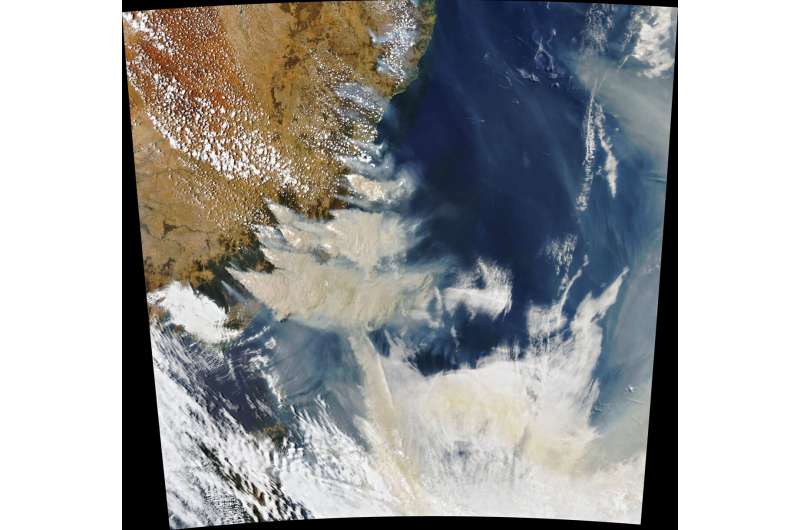This article has been reviewed according to Science X's editorial process and policies. Editors have highlighted the following attributes while ensuring the content's credibility:
fact-checked
peer-reviewed publication
proofread
Study finds individual extreme forest fires can lead to global impacts

The radiative effects of smoke from individual extreme forest fires can apparently lead to global impacts that influence the energy balance of the atmosphere and thus the global climate in a complex way.
This is the conclusion drawn by a team from the Leibniz Institute for Tropospheric Research (TROPOS) from an analysis of the extreme 2019/20 forest fires in Australia using simulations with a global aerosol climate model. The simulated effects of the smoke led to a temperature increase of several degrees Celsius in the upper air layers and to a weakening of circulation in the lower stratosphere.
As a result of further adjustment mechanisms, there is a decrease in relative humidity of around 0.2 percent and precipitation of a similar magnitude. A global impact of the Australian fires on our weather and climate can therefore not be ruled out, the researchers write in Atmospheric Chemistry and Physics.
The Black Summer forest fires in Australia around the turn of the year 2019/2020 were extraordinary: extreme pyroconvective smoke clouds (pyroCb) transported unprecedented amounts of smoke into the lower stratosphere. Between 29 December 2019 and 4 January 2020, several such events transported between 0.3 and 2 million tons of smoke particles to altitudes of 12 to 14 kilometers.
The smoke layer spread over a large area of the southern hemisphere and could still be detected two years later in the stratosphere by lidar measurements. The intensity of the Australian fires was comparable to that of the last major volcanic eruptions, and the smoke emitted even influenced the Earth's climate: smoke particles heat the atmosphere significantly more due to the soot they contain, in contrast to volcanic aerosol, which mainly reflects sunlight.
This absorption effect was intensively investigated in an earlier TROPOS study and a direct warming rate of the entire southern hemisphere of up to +0.5 watts per square meter was estimated. Even this direct warming effect, which appears relatively simple, was the subject of controversial debate among experts. However, it becomes much more complex when one considers the chain of adjustment mechanisms that our Earth's atmosphere may have subsequently undergone as a result of the effects of Australian smoke.
In order to investigate this mechanism in more detail, the current TROPOS study built on the work from the previous year and used the global aerosol climate model ECHAM-HAM to comprehensively quantify the effects of forest fire particles. With the help of computer simulations, it was possible to show that the absorption of sunlight by the Australian smoke led to a relevant increase in the temperature of the upper troposphere and lower stratosphere by several degrees Celsius.
Excitingly, this did not only occur locally in the southern hemisphere, but the positive temperature anomaly also progressed across the tropics towards the northern hemisphere over the course of a few months. After analyzing the simulation data, this interhemispheric coupling could be attributed to changes in the global circulation, in particular to the weakening of the upwelling southern hemispheric circulation branch.
Interesting evidence was found in the present study for a feedback effect of the stratospheric changes described on our weather systems. For example, the warming of the upper tropospheric layers in the model led to a reduction in relative humidity and thus to a decrease in cirrus clouds. Furthermore, interrelationships were identified that suggest that a decrease in global precipitation of around 0.2 % is within the realms of possibility due to the effect of Australian smoke.
"The exact impacts of extreme fires on our weather and climate are difficult to estimate due to the existing uncertainties. Our study is also affected by these uncertainties. Nevertheless, we were able to find that the Australian fires, which were a tiny source in relation to the entire Earth, have a global impact. Our findings also show that not only the cirrus cloud cover is reduced, but that the entire water cycle could have been weakened by the Australian fires—although the quantitative estimation of these effects is extremely uncertain," says Dr. Fabian Senf from TROPOS.
The TROPOS study has shown that smoke from large forest fires can lead to changes in global circulation. It therefore joins the ranks of various international studies that show evidence of changes on large scales. In 2022, for example, British researchers led by Prof Jim M. Haywood from the University of Exeter warned of the risks of artificially introducing absorbent particles into the stratosphere.
This could strengthen the positive phase of the winter North Atlantic Oscillation, which is associated with flooding in northern Europe and droughts in southern Europe. The far-reaching consequences of smoke in the stratosphere and the potential impact on the troposphere are not yet clear.
"As rapid climate change is increasing the risk and intensity of forest fires, there is an urgent need to improve the description of extreme fires and their effects in global climate models," says Prof Ina Tegen from TROPOS. To this end, it is necessary to better understand the atmospheric conditions that lead to extreme pyro-convective smoke clouds and the characteristics of the smoke particles emitted in order to adequately take these possible interactions into account in the climate projections.
More information: Fabian Senf et al, How the extreme 2019–2020 Australian wildfires affected global circulation and adjustments, Atmospheric Chemistry and Physics (2023). DOI: 10.5194/acp-23-8939-2023
Journal information: Atmospheric Chemistry and Physics
Provided by Leibniz-Institut für Troposphärenforschung e. V.




















